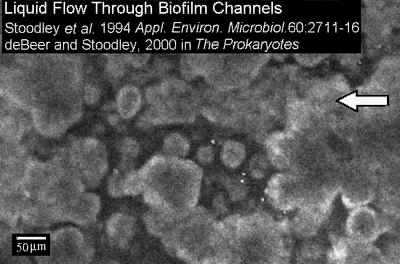A substantially updated version of the hypertextbook is available here. Please migrate to that version. This one will eventually disappear.
Do water channels in biofilms eliminate diffusion limitation?
Structure changes geometry of the diffusion problem
Much has been made over the last decade of the heterogeneous architecture of some biofilms (3, 36). These biofilms are described as clusters of microbial cells that are interspersed with water channels through which liquid flows. It is natural to wonder whether such conduits might ameliorate or even eliminate limitation of diffusive solute transport.

Flow through water channels can improve solute transport in the immediate lining of the channel, but it does not assure access to the interior of cell clusters. Perhaps the best demonstration of this fact is the direct experimental measurement of oxygen penetration to the base of a biofilm in a void area but failure of the oxygen to penetrate in an adjacent cell cluster (8). Water may course through channels, but it does not percolate the cell clusters themselves (see example in previous section). The dense aggregation of bacterial cells and their extracellular polymers within cell clusters precludes fluid flow. This means that water channels can expose the surfaces of clusters or channels but they do not allow free access of solutes to the interior of cell clusters.
Structural heterogeneity in a biofilm changes the geometry of the diffusion problem, but it does not alter the fundamental phenomena. The illustrative calculations presented in this article have all been framed in terms of simple shapes, but the ability to calculate diffusion phenomena is not limited by biofilm geometry in this era of fast computers. Several mathematical models have been described that calculate reaction-diffusion interactions in heterogeneous biofilm structures in two dimensions (12, 15, 23).
